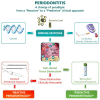Predictive Periodontitis: The Most Promising Salivary Biomarkers for Early Diagnosis of Periodontitis
- PMID: 33916672
- PMCID: PMC8038382
- DOI: 10.3390/jcm10071488
Predictive Periodontitis: The Most Promising Salivary Biomarkers for Early Diagnosis of Periodontitis
Abstract
The primary cause of tooth loss in the industrialized world is periodontitis, a bacterial anaerobic infection whose pathogenesis is characterized by composite immune response. At present, the diagnose of periodontitis is made by a complete status check of the patient's periodontal health; full-mouth plaque score, full-mouth bleeding score, probing depth, clinical attachment level, bleeding on probing, recessions, mobility, and migration are evaluated in order to provides a clear picture of the periodontal conditions of a single patient. Chair-side diagnostic tests based on whole saliva could be routinely used by periodontists for a very early diagnosis of periodontitis, monitoring, prognosis, and management of periodontal patients by biomarker detection, whose diagnostic validity is related to sensitivity and specificity. Recent paper reviews and meta-analyses have focused on five promising host derived biomarkers as candidate for early diagnosis of periodontitis: MMP-8 (Metalloproteinase-8), MIP-1α (Macrophage inflammatory protein-1 alpha), IL-1 β (Interleukin-1 beta), IL-6 (Interleukin-6), and HB (Hemoglobin), and their combinations. Chair-side Lab-on-a-chip (LOC) technology may soon become an important part of efforts to detect such biomarkers in saliva medium to improve worldwide periodontal health in developed nations as well as in underserved communities and poor countries. Their applications in preventive and predictive medicine is now fundamental, and is aimed at the early detection of risk factors or the presence or evolution of the disease, and in personalized medicine, which aims to identify tailor-made treatments for individual patients. The aim of the present paper is to be informative about host derived periodontal biomarkers and, in particular, we intend to report information about the most important immune response derived biomarkers and Hemoglobin as candidates to be routinely utilized in order to obtain a chair-side early diagnosis of periodontal disease.
Keywords: host-derived diagnostic markers; lab-on-a-chip; periodontitis; predictive periodontology; salivary biomarkers.
Conflict of interest statement
The authors declare no conflict of interest.
Figures



References
Publication types
LinkOut - more resources
Full Text Sources
Other Literature Sources
Medical
Research Materials
Miscellaneous

